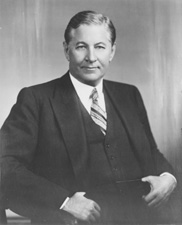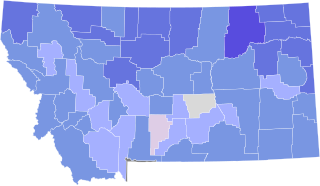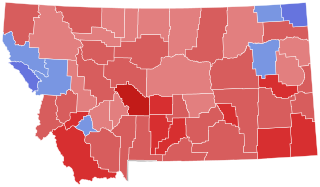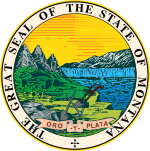
Burton Kendall Wheeler was an attorney and an American politician of the Democratic Party in Montana, which he represented as a United States senator from 1923 until 1947.

John Edward Erickson was an American politician of the Democratic Party from Montana. He served as the eighth Governor of Montana and as a United States senator.

The 2008 United States Senate election in Montana was held on November 4, 2008. Incumbent Senator Max Baucus won re-election to a sixth term in a landslide, winning more than 70% of the vote and carrying every county in the state, despite Republican John McCain's narrow victory in the state in the concurrent presidential election. Baucus later resigned his seat on February 6, 2014 after the Senate confirmed him to be U.S. Ambassador to China, having already announced his intention to retire at the end of term on April 23, 2013. As of 2024, this is the last time Democrats won the Class 2 Senate seat in Montana.

The 1988 United States Senate election in Montana took place on November 8, 1988. Incumbent United States Senator John Melcher, who was first elected to the Senate in 1976 and was re-elected in 1982, ran for re-election. After winning the Democratic primary, he faced Yellowstone County Commissioner Conrad Burns in the general election, and a grueling campaign followed. Ultimately, Melcher was narrowly defeated in his bid for re-election by Burns, who became the first Republican Senator from Montana in 36 years since Zales Ecton lost re-election in 1952.

The 1996 United States Senate election in Montana took place on November 5, 1996. Incumbent United States Senator Max Baucus, who was first elected in 1978 and was re-elected in 1984 and 1990, ran for re-election. He was unopposed in the Democratic primary, and moved on to the general election, where he faced a stiff challenge in Denny Rehberg, the Lieutenant Governor of Montana and the Republican nominee. Despite Bob Dole's victory over Bill Clinton and Ross Perot in the state that year in the presidential election, Baucus managed to narrowly win re-election over Rehberg to secure a fourth term in the Senate.

The 1930 United States Senate election in Montana took place on November 4, 1930. Incumbent United States Senator Thomas J. Walsh, who was first elected to the Senate in 1912, and re-elected in 1918 and 1924, ran for re-election. He won the Democratic primary unopposed, and faced Montana Supreme Court Associate Justice Albert J. Galen, the Republican nominee, and several independent opponents in the general election. Ultimately, Walsh defeated his opponents in a landslide and won his fourth and final term in the Senate.

The 1934 United States Senate special election in Montana took place on November 6, 1934. Incumbent United States Senator John E. Erickson, who, as governor, had appointed himself to the seat in 1933 upon the death of Thomas J. Walsh, ran for re-election. However, he was defeated in the Democratic primary by James E. Murray, who was the former Silver Bow County Attorney and the Chairman of the State Advisory Board of the Public Works Administration. In the general election, Murray defeated Scott Leavitt, a former United States Congressman who had represented Montana's 2nd congressional district, and an independent candidate in a landslide to win his first term in the Senate.

The 1930 United States Senate election in Montana took place on November 3, 1936. Incumbent United States Senator James E. Murray, who was first elected to the Senate in a special election in 1934, ran for re-election. He narrowly emerged from a competitive and close Democratic primary, wherein he was challenged by United States Congressman Joseph P. Monaghan, who represented Montana's 1st congressional district. In the general election, Murray was opposed by Thomas O. Larson, a State Senator and the Republican nominee, and Monaghan, who, after losing the primary, ran as an independent candidate. Murray ended up winning a second term, and his first full term, in a landslide, defeating both of his opponents by a comfortable margin.

The 1942 United States Senate election in Montana took place on November 3, 1942. Incumbent United States Senator James E. Murray, who was first elected to the Senate in a special election in 1934 and was re-elected in 1936, ran for re-election. Following his victory in a competitive Democratic primary, Murray advanced to the general election, where he was opposed by former United States Attorney for the District of Montana Wellington D. Rankin, the Republican nominee and brother of representative Jeannette Rankin. In a closely fought election, Murray narrowly defeated Rankin to win re-election to his third term and his second full term in the Senate.

The 1948 United States Senate election in Montana took place on November 2, 1948. Incumbent United States Senator James E. Murray, who was first elected to the Senate in a special election in 1934 and was re-elected in 1936 and 1942, ran for re-election. After winning the Democratic primary, he faced Tom J. Davis, an attorney and the Republican nominee, in the general election. Following a narrow re-election in 1936, Murray significantly expanded his margin of victory and comfortably won re-election over Davis, resulting in him winning his fourth term and his third full term in the Senate.

The 1954 United States Senate election in Montana took place on November 2, 1954. Incumbent United States Senator James E. Murray, who was first elected to the Senate in a special election in 1934 and was re-elected in 1936, 1942, and 1948, ran for re-election. After winning the Democratic primary against trivial opponents, he advanced to the general election, where he was opposed by Wesley A. D'Ewart, the Republican nominee and the United States Congressman from Montana's 2nd congressional district. A contentious and close election ensued, but ultimately, Murray was able to narrowly win re-election over D'Ewart to a final term in the Senate.

The 1960 United States Senate election in Montana took place on November 8, 1960. Incumbent United States Senator James E. Murray, who was first elected to the Senate in a special election in 1934 and was re-elected in 1936, 1942, and 1948, and 1954, declined to seek re-election, creating an open seat. United States Congressman Lee Metcalf won out in a crowded Democratic primary and faced off against former United States Congressman Orvin B. Fjare, who won in a similarly-crowded Republican primary. Following a close general election, Metcalf narrowly defeated Fjare to win his first term in the Senate.

The 1972 United States Senate election in Montana took place on November 7, 1972. Incumbent United States Senator Lee Metcalf, who was first elected to the Senate in 1960 and was re-elected in 1966, ran for re-election. After winning the Democratic primary, he moved on to the general election, where he faced Hank Hibbard, a State Senator and the Republican nominee. Following a close campaign, Metcalf managed to narrowly win re-election to his third term in the Senate over Hibbard. Montana was one of fifteen states alongside Alabama, Arkansas, Colorado, Delaware, Georgia, Iowa, Louisiana, Maine, Minnesota, Mississippi, New Hampshire, Rhode Island, South Dakota and West Virginia that were won by Republican President Richard Nixon in 1972 that elected Democrats to the United States Senate.

The 1922 United States Senate election in Montana took place on November 7, 1922. Incumbent United States Senator Henry L. Myers, who was first elected to the Senate in 1910, and was re-elected in 1916, declined to seek re-election. Former United States Attorney Burton K. Wheeler won the Democratic primary and advanced to the general election, where he faced Carl W. Riddick, the United States Congressman from Montana's 2nd congressional district and the Republican nominee. Ultimately, Wheeler defeated Riddick comfortably and won his first term in the Senate.

The 1928 United States Senate election in Montana took place on November 6, 1928. Incumbent United States Senator Burton K. Wheeler, who was first elected to the Senate in 1922, ran for re-election. After successfully defeating several challengers in the Democratic primary, Wheeler advanced to the general election, where he faced Republican nominee Joseph M. Dixon, the former Governor of Montana who had previously served in the United States Senate from 1907 to 1913. Though the election was closer than Wheeler's first election, he still managed to defeat Dixon to win his second term in the Senate.

The 1934 United States Senate election in Montana took place on November 6, 1934. Incumbent United States Senator Burton K. Wheeler, who was first elected to the Senate in 1922, and was re-elected in 1928, ran for re-election. After easily winning the Democratic primary, Wheeler moved on to the general election, where he faced George M. Bourquin, a former United States Federal Judge and the Republican nominee. In a stark contrast to his close campaign in 1928, Wheeler won re-election to his third Senate term in a landslide.

The 1946 United States Senate election in Montana took place on November 5, 1946. Incumbent United States Senator Burton K. Wheeler, who was first elected to the Senate in 1922, and was re-elected in 1928, 1934, and 1940, ran for re-election. He was challenged in the Democratic primary by Leif Erickson, the Chief Justice of the Montana Supreme Court, and, following a close election, was narrowly defeated by Erickson. In the general election, Erickson faced State Senator Zales Ecton, the Republican nominee. Ultimately, Ecton defeated Erickson by a fairly wide margin, winning his first and only term in the Senate. Another Republican would not be elected Senator from Montana until 42 years later, when Conrad Burns narrowly won the 1988 election.

The 1952 United States Senate election in Montana took place on November 4, 1952. Incumbent United States Senator Zales Ecton, who was first elected to the Senate in 1946, ran for re-election. Ecton won the Republican primary uncontested, and advanced to the general election, where he faced Mike Mansfield, the United States Congressman from Montana's 1st congressional district and the Democratic nominee. Following a close campaign, Mansfield narrowly defeated Ecton, winning his first of several terms in the Senate.

The 1964 United States Senate election in Montana took place on November 3, 1964. Incumbent United States Senator Mike Mansfield, who was first elected to the Senate in 1952 and was re-elected in 1958, ran for re-election. Mansfield won the Democratic primary in a landslide, and advanced to the general election, where he faced Alex Blewett, the Majority Leader of the Montana House of Representatives and the Republican nominee. Though Mansfield's margin was quite reduced from 1958, he still overwhelmingly defeated Blewett and won his third term in the Senate in a landslide.

The 1920 Montana gubernatorial election took place on November 2, 1920. Incumbent Governor of Montana Sam V. Stewart, who was first elected Governor in 1912 and 1916, declined to run for re-election. To replace him, former United States Senator Joseph M. Dixon won the Republican primary, which was closely contested. In the general election, he faced Burton K. Wheeler, the former United States Attorney for the District of Montana and the Democratic nominee. Ultimately, Dixon defeated Wheeler by a wide margin to win his first and only term as governor.





















